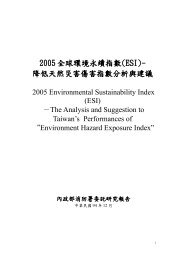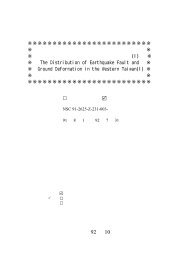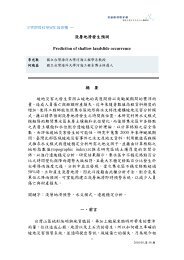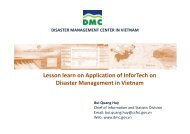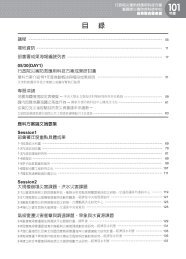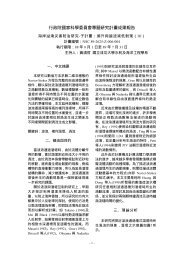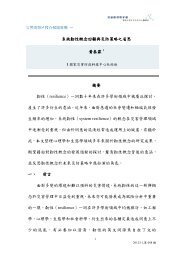Development of Decision Support System for Early Warning and ...
Development of Decision Support System for Early Warning and ...
Development of Decision Support System for Early Warning and ...
Create successful ePaper yourself
Turn your PDF publications into a flip-book with our unique Google optimized e-Paper software.
<strong>Development</strong> <strong>of</strong> <strong>Decision</strong> <strong>Support</strong> <strong>System</strong> <strong>for</strong><br />
<strong>Early</strong> <strong>Warning</strong> <strong>and</strong> Mitigation against<br />
Typhoon Hazard<br />
Feng-Tyan Lin, Pai-Hui Hsu<br />
ftlin@ntu.edu.tw, paihui@ncdr.nat.gov.tw<br />
In<strong>for</strong>mation Division<br />
National Science & Technology Center <strong>for</strong> Disaster Reduction
In<strong>for</strong>mation flow to the NEOC
In<strong>for</strong>mation flow to the Taipei’s DMIS
<strong>Decision</strong> <strong>Support</strong> <strong>System</strong> <strong>for</strong> <strong>Early</strong> <strong>Warning</strong><br />
• A <strong>Decision</strong> <strong>Support</strong> <strong>System</strong> <strong>for</strong> <strong>Early</strong> <strong>Warning</strong> (DSSEW)<br />
was developed by NCDR <strong>for</strong> typhoon hazards.<br />
• The DSSEW is designed to integrate the real-time<br />
monitoring data, the dynamic hazard models <strong>and</strong> Web-GIS<br />
technology to provide disaster management<br />
decision<br />
support tools <strong>for</strong> early warning.<br />
• The input data <strong>of</strong> this system includes:<br />
• the basic maps<br />
• the real-time in<strong>for</strong>mation <strong>of</strong> typhoon <strong>and</strong> rainfall issued by the<br />
Central Weather Bureau<br />
• the real-time water in<strong>for</strong>mation from the Water Resources<br />
Agency<br />
• the hazard maps indicating areas <strong>of</strong> potential l<strong>and</strong>slide, debris<br />
flow <strong>and</strong> flooding made by NCDR herself<br />
• The results <strong>of</strong> analysis <strong>and</strong> warning messages are finally<br />
delivered to the Central Emergency Operations Center<br />
(CEOC) <strong>and</strong> help the comm<strong>and</strong>er to make the right<br />
decisions in disaster preparedness <strong>and</strong> response phases.
The Framework <strong>of</strong> DSSEW<br />
Input<br />
In<strong>for</strong>mation <strong>for</strong><br />
Post-Disaster Recovery<br />
Basic Maps<br />
Hazards Maps<br />
Real-Time In<strong>for</strong>mation<br />
Rainfall Monitoring<br />
QPE-SUMS Radar <strong>System</strong><br />
Water In<strong>for</strong>mation<br />
Plat<strong>for</strong>m <strong>for</strong><br />
Data Sharing<br />
Disaster Analysis <strong>and</strong> <strong>System</strong> Integration<br />
Data<br />
Warehouse<br />
Metadata<br />
Establishment<br />
Data<br />
St<strong>and</strong>ardization<br />
Data<br />
Visualization<br />
Management<br />
Of S<strong>of</strong>tware<br />
<strong>and</strong> Hardware<br />
Integrated with QPE-SUMS<br />
Radar <strong>System</strong><br />
Automatic Estimation <strong>of</strong><br />
Inundation Areas<br />
Automatic Estimation <strong>of</strong> Debris<br />
Flow <strong>and</strong> L<strong>and</strong>slide Areas<br />
Integrated with TELES <strong>System</strong><br />
Risk Assessment<br />
Risk Analysis <strong>of</strong> Toxic Substance<br />
Release<br />
Disaster Investigation<br />
In<strong>for</strong>mation <strong>System</strong><br />
Meteorology Division<br />
Flood <strong>and</strong> Drought<br />
Disasters Reduction Division<br />
Slopel<strong>and</strong><br />
Disaster Reduction Division<br />
Earthquake<br />
Disaster Reduction Division<br />
Socio-Economic <strong>System</strong> Division<br />
Technology <strong>and</strong> Manmade<br />
Disasters Reduction Division<br />
In<strong>for</strong>mation Division<br />
Web-GIS (GUI Interface)<br />
Output<br />
Rainfall<br />
Forecasting<br />
Inundation<br />
Potential<br />
Debris Flow<br />
Potential<br />
Damage<br />
Assessment<br />
Earthquake<br />
Potential<br />
Toxic Risk<br />
Potential<br />
Disaster<br />
Investigation<br />
Governmental<br />
Agencies <strong>and</strong><br />
NGOs<br />
In<strong>for</strong>mation<br />
<strong>for</strong> <strong>Early</strong><br />
<strong>Warning</strong><br />
<strong>Decision</strong> Makers<br />
WEBGIS<br />
Single Signon<br />
Users
The Framework Of Common Plat<strong>for</strong>m For<br />
Disaster In<strong>for</strong>mation Sharing<br />
Data Collection Tools<br />
Info Common Plat<strong>for</strong>m<br />
National In<strong>for</strong>mation Center <strong>for</strong> Disaster Reduction<br />
Disaster<br />
Metadata<br />
Disaster<br />
Experts<br />
Database<br />
Database<br />
Knowledge<br />
Database<br />
Base<br />
Disaster<br />
Operations<br />
Damage<br />
Assessment<br />
Risk Analysis<br />
e-Government<br />
Common Plat<strong>for</strong>m<br />
E-Taiwan<br />
Common Plat<strong>for</strong>m<br />
Other<br />
Common Plat<strong>for</strong>m<br />
XML, GML<br />
Network<br />
Technology<br />
Common Plat<strong>for</strong>m<br />
Web Services<br />
Open Netwrok Protocal(SMTP,SOAP, …)<br />
XML, GML<br />
OS Services<br />
XML, GML<br />
XML, GML<br />
Monitoring<br />
Response &<br />
<strong>Early</strong> <strong>Warning</strong><br />
Planninge &<br />
Management<br />
Revovery &<br />
Reconstrution<br />
…<br />
Database<br />
Central Gov.<br />
Database<br />
E-Taiwan<br />
Database<br />
NCDR<br />
Database<br />
NGIS<br />
Database<br />
Local Gov.<br />
Database<br />
Other<br />
Database<br />
Info. <strong>System</strong>s<br />
Central Gov.<br />
Info. <strong>System</strong>s<br />
E-Taiwan<br />
Info. <strong>System</strong>s<br />
NCDR<br />
Info. <strong>System</strong>s<br />
Local Gov.<br />
Info. <strong>System</strong>s
The data flow <strong>of</strong> Disaster Metadata<br />
Management <strong>System</strong><br />
Automatic import <strong>of</strong><br />
matadata with NGIS <strong>for</strong>mat<br />
Disaster Metadata<br />
Management <strong>System</strong><br />
Adding new metadata using<br />
the web-based interface<br />
" 詮 釋 資 料 編 號 :200209061445020001"<br />
" 檔 名 :"<br />
"1. 識 別 資 訊 :"<br />
" 1.1 引 用 資 訊 :"<br />
" 1.1.1 生 產 者 :"<br />
" 1.1.1 生 產 者 1: 內 政 部 地 政 司 "<br />
" 1.1.2 發 表 日 期 :2000"<br />
" 1.1.3 發 表 時 間 : 未 知 "<br />
" 1.1.3-1 時 間 形 態 :"<br />
¡§ 1.1.4 標 題 : 地 政 司 圖 幅 索 引 圖 ¡¨<br />
.<br />
.<br />
Metadata<br />
Database<br />
Exporting the metadata via XML <strong>and</strong><br />
RSS <strong>for</strong>mats<br />
Displaying the results <strong>of</strong> queried maps<br />
using Web-GIS
Distribution Of <strong>Early</strong> <strong>Warning</strong> In<strong>for</strong>mation<br />
Using Web-service/XML Technology<br />
Real-Time<br />
Monitoring<br />
Data<br />
<strong>Decision</strong> <strong>Support</strong> <strong>System</strong><br />
<strong>for</strong> Emergency Response<br />
Disaster<br />
Database<br />
Hazards<br />
Models<br />
Analysis &<br />
<strong>Decision</strong> Making<br />
XML<br />
Web Services (UDDI, WSDL, SOAP)<br />
XML<br />
XML<br />
XML<br />
Other<br />
Database<br />
Other<br />
Analyst<br />
Other<br />
Users
Geo Data Base<br />
Geodatabase<br />
Geodatabase<br />
Administration<br />
boundary<br />
village border<br />
Map frame<br />
Water system Ficilities Rainfall Flood Debris flow Earthquake<br />
county Basic border Maps drainage border<strong>and</strong><br />
road<br />
town border<br />
Statistics<br />
watershed border<br />
river<br />
Image data<br />
1/50000<br />
color topograph<br />
Historical <strong>and</strong><br />
1/25000<br />
base map<br />
1/5000<br />
DTM<br />
Potential<br />
color l<strong>and</strong>scape<br />
Disasters<br />
gray l<strong>and</strong>scape<br />
Basic map<br />
railroad<br />
building<br />
street block<br />
school<br />
l<strong>and</strong>mark<br />
reservoir<br />
raingage<br />
station<br />
rainfall map<br />
rainfall<br />
records<br />
Real time<br />
Disaster<br />
raingage<br />
station<br />
l<strong>and</strong>slide<br />
potential hazard<br />
zone<br />
inundation<br />
map<br />
historical hazard<br />
site<br />
In<strong>for</strong>mation<br />
l<strong>and</strong>slide site<br />
debrisflow<br />
potential hazard<br />
streams<br />
active fault<br />
geology map<br />
chi-chi<br />
earthquake<br />
building damage<br />
sites<br />
Geo-database <strong>for</strong> Disaster Management In<strong>for</strong>mation <strong>System</strong>s
Severe Weather <strong>Early</strong> <strong>Warning</strong> <strong>and</strong> Monitoring<br />
Satellites<br />
Upper air<br />
sounding<br />
Regional Model<br />
Radar Network<br />
Data analysis<br />
Storm analysis<br />
Storm tracking<br />
Rainfall estimate<br />
Historical case<br />
...<br />
Surface stations<br />
Auto rain-gauge<br />
Lightening observations
The User Interface <strong>for</strong> the Rainfall Distribution
Rainfall Distribution Estimated from<br />
the QPE-SUMS Radar <strong>System</strong><br />
+<br />
Rainfall Hydrograph Query
The Inundation Potential Maps in Taiwan<br />
• The flood <strong>and</strong> drought<br />
mitigation research group<br />
had finished the isl<strong>and</strong>-wide<br />
inundation potential maps in<br />
2001.<br />
• For floodplain managements<br />
• For flood mitigations<br />
• Incorporation with socialeconomic<br />
in<strong>for</strong>mation<br />
Taipei City<br />
Depth : m<br />
0.50 - 1.50<br />
1.50 - 2.50<br />
2.50 - 3.50<br />
3.50+<br />
Kaohsiung City
National<br />
Disaster Response Center<br />
Real Time Rainfall<br />
Data<br />
Typhoon Path<br />
Prediction<br />
Meteorological<br />
models<br />
flood areas<br />
Database<br />
Case<br />
Retrieval<br />
Detail<br />
meteorological map<br />
L<strong>and</strong>slide<br />
Database<br />
Real-time<br />
flooding area<br />
Potential flood<br />
area prediction<br />
Potential l<strong>and</strong>slide<br />
area prediction<br />
L<strong>and</strong>slide disaster<br />
response system<br />
Socio-economic<br />
Losses prediction<br />
Transportation<br />
system
Estimation <strong>of</strong> Inundation <strong>and</strong> <strong>Warning</strong> Issue<br />
River<br />
County boundary<br />
Township boundary<br />
Highway<br />
Major road<br />
Real-time Rainfall Records<br />
+<br />
Rainfall Forecasting<br />
Flood Potential<br />
Highest (avg. depth > 1.5 m)<br />
Higher (avg. depth 1.0m – 1.5m)<br />
High (avg. depth 0.5m – 1.0 m)
The User Interface <strong>for</strong> the Forecasting <strong>of</strong> the<br />
Inundation Potential Areas
Potential Streams <strong>of</strong> Debris Flow<br />
in Taiwan<br />
Geology Zoning <strong>of</strong> 1420 Potential<br />
Streams <strong>of</strong> Debris Flow
Issues the <strong>Warning</strong> <strong>and</strong> Security <strong>for</strong> the Counties <strong>of</strong><br />
the Slopel<strong>and</strong> Disaster Vulnerability<br />
Meteorological data<br />
Rainfall distribution<br />
Forecast rainfall distribution<br />
Threshold<br />
Slopel<strong>and</strong> disaster threshold<br />
Forecast disaster locations<br />
Disaster location <strong>of</strong> the same<br />
typhoon tracking be<strong>for</strong>e vs.<br />
rainfall distribution<br />
Slopel<strong>and</strong> disaster Vulnerability<br />
Forecast traffic interruption<br />
location<br />
No<br />
Accumulative rainfall R<br />
(unit: mm)<br />
Averaged rainfall intensity<br />
I avg = R/D (unit: mm/hr)<br />
Start <strong>of</strong> a rainfall event (t 1<br />
)<br />
(unit: hr)<br />
Current time (t 2<br />
)<br />
(unit: hr)<br />
Rainfall duration D = t 2<br />
-t 1<br />
(unit: hr)<br />
I avg<br />
> I c<br />
Yes<br />
Debris flow threshold line<br />
I c = 115.47D I -0.8<br />
c<br />
(unit: mm/hr)<br />
Display streams <strong>and</strong> regions over threshold in WebGIS<br />
Judgments <strong>of</strong> regions prone to debris flow<br />
<strong>Warning</strong> <strong>of</strong> debris flow prone areas
The User Interface <strong>for</strong> the Forecasting <strong>of</strong><br />
the Slopel<strong>and</strong> Disaster Locations
Basic Maps<br />
Rainfall <strong>for</strong>ecasting by<br />
CLIPPER model<br />
Rainfall <strong>for</strong>ecasting by<br />
QPE-SUMS radar system<br />
Typhoon Path<br />
Prediction<br />
Analysis <strong>and</strong><br />
<strong>Decision</strong> Making<br />
Real-Time Water In<strong>for</strong>mation<br />
<strong>of</strong> rivers by Web-Services<br />
Technology<br />
Automatic Estimation<br />
<strong>of</strong> Inundation Area<br />
Inundation<br />
Potential Maps<br />
Debris Flow <strong>and</strong><br />
l<strong>and</strong>slide<br />
in<strong>for</strong>mation<br />
Automatic Estimation <strong>of</strong> the<br />
potential areas <strong>of</strong> Debris<br />
Flows <strong>and</strong> L<strong>and</strong>slide<br />
Management <strong>of</strong> Disaster<br />
Investigation<br />
Central <strong>Warning</strong><br />
Declaration<br />
NEOC
Outcome by the Active Reduction Measures<br />
Typhoon Event<br />
Max. hourly<br />
Rainfall (mm/hr)<br />
Total Accumulated<br />
Rainfall (mm)<br />
L<strong>and</strong>slide &<br />
Debris Flow<br />
Occurrence<br />
Evacuation<br />
(Person)<br />
Ceased <strong>and</strong><br />
Missing<br />
(Person)<br />
2001.7.28<br />
Toraji 147<br />
2001.9.17<br />
Nari 142<br />
2004.6.30<br />
Mindulle 167<br />
147 757 673 ---- 214<br />
142 1,462 475 24,000 104<br />
167 2,005 1,023 9,500 41<br />
Decreasing <strong>of</strong> victims<br />
2005.7.18<br />
Haitang 177<br />
177 2,124 605 1,208 15<br />
Passive Rescue<br />
(Toraji)<br />
Proactive assessment <strong>and</strong> evacuation<br />
(Nari, Midulle, <strong>and</strong> Haitang)
Spatial Policy Simulation <strong>for</strong> Hazard Mitigation<br />
population <strong>and</strong> economic<br />
growth trend<br />
Disaster<br />
potential<br />
Scenario<br />
Analysis<br />
Threshold<br />
setting<br />
Policy: l<strong>and</strong> use zoning <strong>and</strong> building management
L<strong>and</strong> use zoning map
Service areas <strong>of</strong> refuges
Service Areas <strong>of</strong> Major Roads <strong>for</strong> Disaster Response
Scenario Analysis on Population Distribution
Summaries<br />
• A <strong>Decision</strong> <strong>Support</strong> <strong>System</strong> <strong>for</strong> <strong>Early</strong> <strong>Warning</strong> (DSSEW) was<br />
developed <strong>for</strong> preparedness <strong>and</strong> response <strong>of</strong> typhoon<br />
hazards.<br />
• This system is base on the Web-GIS framework that the<br />
disaster in<strong>for</strong>mation can be distributed via internet technology.<br />
• When typhoon is coming, the DSSEW is used to integrate<br />
real-time monitoring in<strong>for</strong>mation, hazard models <strong>and</strong> graphical<br />
user interfaces to analyze <strong>and</strong> manage the disaster<br />
in<strong>for</strong>mation such as the current position <strong>and</strong> possible path <strong>of</strong><br />
typhoon, the spatial distribution <strong>of</strong> rainfalls, <strong>and</strong> potential<br />
areas <strong>of</strong> flooding, l<strong>and</strong>slides <strong>and</strong> debris flows.<br />
• The results <strong>of</strong> hazard analysis <strong>and</strong> warning messages are<br />
finally delivered to the Central Emergency Operations Center<br />
(CEOC) <strong>and</strong> help the comm<strong>and</strong>er to make the right decisions<br />
in disaster preparedness <strong>and</strong> response phases.<br />
• The active assessment <strong>and</strong> evacuation <strong>for</strong> typhoon events<br />
using the DSSEW has proven effective <strong>for</strong> the reduction <strong>of</strong><br />
property damages <strong>and</strong> life losses.
Future Works<br />
• Taking the advantages <strong>of</strong> the National GIS<br />
programs in Taiwan.<br />
• Establishing data exchange st<strong>and</strong>ard <strong>and</strong> common<br />
plat<strong>for</strong>m <strong>for</strong> in<strong>for</strong>mation sharing.<br />
• Advanced in<strong>for</strong>mation technology should be<br />
employed<br />
• GRID COMPUTING<br />
• EXPERT SYSTEMS<br />
• CASE BASED REASONING<br />
• Participating International In<strong>for</strong>mation Cooperation<br />
Projects.
Thank you<br />
<strong>for</strong> your attention!!!



